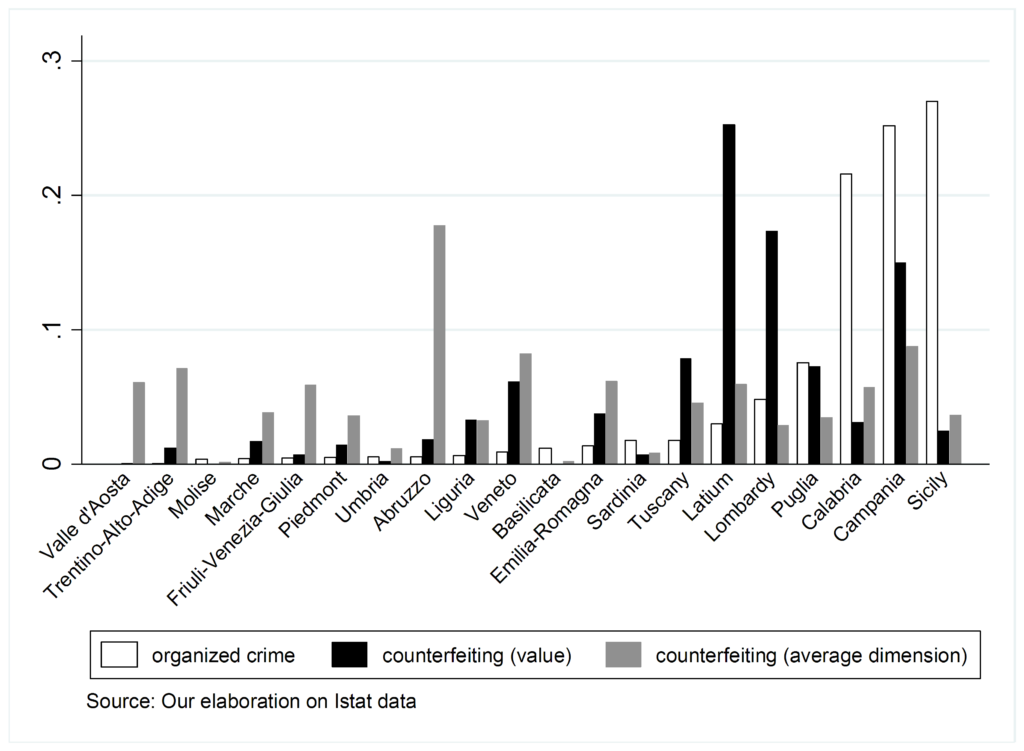Policy tolerance of economic crime? An empirical analysis of the effect of counterfeiting on Italian trade
Beqiraj E., Fedeli S., Giuriato L., 2020 – European Journal of Political Economy
Some economic crimes are perceived as being more unethical than illegal, both in the public opinion and by politicians. As a consequence, public policies might exhibit wide tolerance margins regarding these crimes. In Italy, this has been the case with regard to corruption, tax evasion, and other forms of economic crime.
In the article Policy tolerance of economic crime? An empirical analysis of the effect of counterfeiting on Italian trade, recently published in the European Journal of Political Economy, Elton Beqiraj, Silvia Fedeli, and Luisa Giuriato offer an empirical analysis on a specific economic crime, counterfeiting, andits economic effects in Italy.
Counterfeiting is the unauthorized manufacturing of articles, which mimic certain characteristics of genuine goods and may pass themselves off as registered products of licit companies. This phenomenon severely affects the Italian industrial system, which is made up of small-medium export-oriented firms. It compromises the advantage of these firms, namely, their capacity to create high quality products that are highly reputed and saleable on foreign markets.
Its impact on the Italian economy is relevant, indeed: according to CENSIS-UIBM’s estimates (2018), counterfeiting results in a loss of about € 19.4 billion production and 103,000 jobs in the legal market. Moreover, the country is ranked third, after the US and France, in the list of economies of origin of right holders whose intellectual property rights (IPRs) are infringed upon (OECD, 2019). At the same time, unlike other European countries, Italy displays a significant propensity to produce and export counterfeited goods. Both economically depressed regions (Abruzzo, Calabria) and flourishing regions (Veneto, Emilia-Romagna, and Lombardy) attract counterfeiting: the former regions host a favourable reserve of unemployed workers and criminal activities, whereas the latter offer opportunities for fakes’ distribution and commercialisation (Graph 1).

regional share (2008-2013)
Overall, counterfeiting stands out as a complex phenomenon with many intertwined contradictions. Counterfeiting is a serious crime problem in Italy, it is run by mafia-type organisations that have increasingly turned their activities towards this highly remunerative, relatively low-risk business. It is, therefore, a serious challenge to business freedom and a multiplier of illegal activities, including tax evasion, illegal migration, unreported employment, and money laundering. At the same time, counterfeiting has been “politically” tolerated for positive returns in terms of (shadow) employment, income, and exchanges, and in terms of political clientelism: it is a social buffer in areas of widespread unemployment, social and economic depression, and insufficient public control of the territory. It is also socially tolerated: about one-third of Italian consumers buys at least one fake product or utilizes an illegal service each year.
The policy stance against counterfeiting is ambiguous. For instance, some anti-counterfeiting measures were approved during the economic crisis to counter its adverse effects on competition and legal businesses, and also to protect the country’s reputation for high-quality products: penalties were tightened and investigation tools were expanded (Piano straordinario contro le mafie, Law 136/2010). However, these same measures – possibly because of public budget constraints or perceived low harmfulness of counterfeiting – were not supported by increased enforcement resources.
Given these premises, the authors assess the economic impact of counterfeiting by investigating its effect on trade (imports and exports), using a dynamic panel model and a newly built dataset for the crisis years 2008-2013. The dataset contains detailed data on crime (from the Italian Ministry of Justice) and data on both the average dimension of fakes’ seizures in each region and the estimated value of the seized counterfeits (from the Intellectual Property Elaborated Report of the Investigation on Counterfeiting database).
As expected, the results show the ambivalent nature of counterfeiting that has a twofold effect on trade. On the one hand, evidence shows a positive influence of counterfeiting on trade: counterfeiting increases trade flows to the benefit of the shadow economy. On the other hand, however, results also show a negative impact on trade indicators, which comes from substandard imitation and brand confusion, especially in high added-value sectors that suffer from credibility losses, substitution effects by illicit goods, and the destruction of genuine competitiveness. Still, the overall net impact of counterfeiting is negative.
The simultaneous presence of both a positive and a negative impact on trade of the two variables for the value and the dimension of counterfeiting confirms the dual impact of fake products, which both depress the legal market relying on IPRs and support Italian economic activity in the shadow market. These positive economic returns of counterfeiting can potentially make fighting it more difficult, weaken repression by public authorities, and pave the way for tolerance – a mix of inertia and complicity. However, evidence of the overall negative net impact of counterfeiting on exports and trade openness should call for the abandonment of the so far ambiguous policy stances towards what is considered a ‘soft’ form of economic crime. This is especially important for the South of the country. Indeed, while Northern regions’ strong economic systems might limit the damages, in Southern regions tolerance of counterfeiting activities, in the hope of beneficial effects on the local economy, contributes to inhibiting economic development and perpetuating stagnation.
These concluding remarks are at the basis of what comes next in terms of fight against counterfeiting, which requires clearer policy stances and more adequate resources. Italy is a late comer in this respect. The General Department against Counterfeiting in the Ministry for Economic Development was only created in 2009 and the inter-ministry coordination council (CNAC) in 2010. The staffing of the police forces is inadequate, and the budget resources devoted to anti-counterfeiting measures by the Ministry for Economic Development (€ 69 million in 2021) are only for 1/3 devoted to actual actions to protect industrial property and against counterfeiting.

